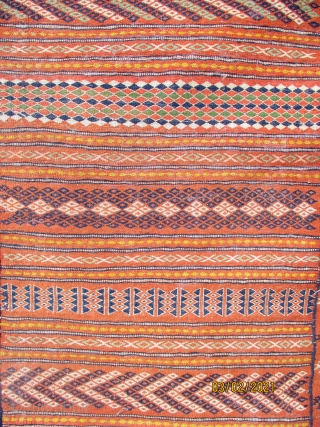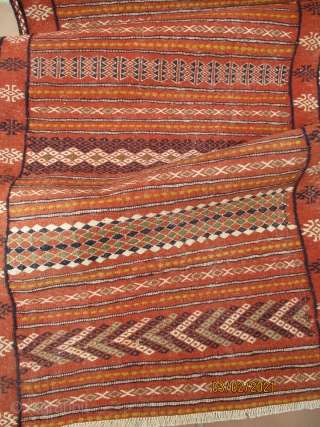Back
kurdish kilim from the kurds of quchan which lies north of Meshed. Although Quchan is the main gathering point for the Kurdish rugs, bags, trappings and kilims few are woven in the town itself and most are brought to the bazaar from the hundreds of surrounding villages. The area has from the early 1600s been home to some Afshar and Balouch people and today the intermarriages between all groups means that identification of some weavings is very difficult. Shorter ruuner formats, called "Soffrehs" are spread on the ground in tents or dwellings for the service of communal bowls of food at family mealtimes. The number of longer runners like this is very few. a kilim with rich yet pastel shades similar to this one is shown as plate 135 in the excellent book "kordi" by Wilfried Stanzer and is attributed to the Kurds of the region of Lain, Reference 3332. Size 336 x 85 cms., or 11ft. x 2ft. 10ins. Euros 535. sold.
price:
euros 535 SOLD
- Home
- Antique Rugs by Region
- Category
- Profiles
- Post Items Free
- Albums
- Benaki Museum of Islamic Art
- Budapest: Ottoman Carpets
- Gulbenkian Museum
- Islamic Carpets. Brooklyn
- Islamic Textiles. Brooklyn
- Konya Museum: Rugs
- MKG, Hamburg
- MMA: Caucasian Carpets
- MMA: Mamluk Carpets
- MMA: Mughal Indian Carpets
- MMA: Ottoman Carpets
- MMA: Safavid Persian Carpets
- MMA: Turkmen Rugs
- McCoy Jones Kilims
- Ottoman textiles. Met
- Philadelphia Museum
- Rugs and Carpets: Berlin
- Seljuqs at the Met
- TIEM, Istanbul: Carpets
- V&A: Classical Carpets
- Vakiflar Carpets: Istanbul
- Baluch Rugs: Indianapolis
- Gallery Exhibitions
- Jaf an Exhibition
- Alberto Levi Gallery
- Andean Textile
- Christie's London: 2016
- Francesca Galloway
- HALI at 40
- ICOC Washington, DC 2018
- Jajims of the Shahsavan
- London Islamic Week April, 2018
- Mongolian Felts
- Navajo Rugs: JB Moore
- Persian Piled Weavings
- SF Tribal & Textile Art Show 2020
- SF Tribal 2019
- Sotheby's: C. Alexander
- Turkish Prayer Rugs
- Turkmen Main Carpets ICOC 2007













